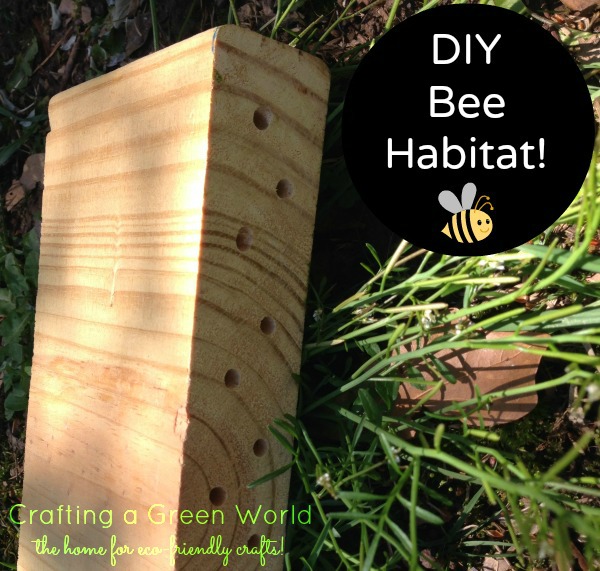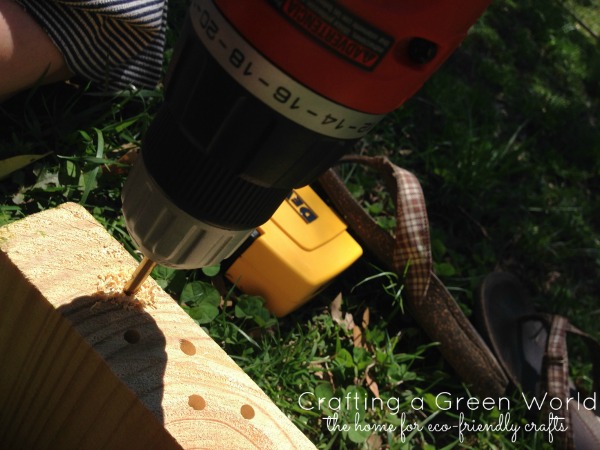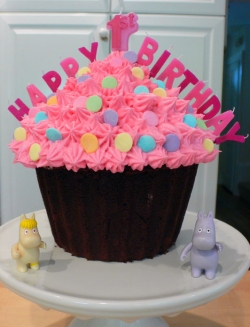
Pollinators like native bees are an important part of any healthy garden. Here’s how to build a native bee habitat with wood left over from other projects!
This tutorial is part of Garden Week here at Crafting a Green World. We’ve teamed up with some of our favorite DIY bloggers to talk about all things gardening! Today, I wanted to talk a little bit about pollinators and share this simple DIY native bee habitat that you can build to protect bees in your area.
We need bees. Native bees and other native pollinators pollinate a huge portion of the food that we eat. Unfortunately, pesticide overuse and habitat destruction are both contributing big-time to something called colony collapse disorder. Native bees and other pollinators are disappearing at an alarming rate, and this simple native bee habitat can help make a difference!
Just nestle this native bee habitat in your yard, making sure that the holes face east or southeast. You want the front to get some morning sun, and you also want to choose a spot that’s semi-protected from weather. Build just one native bee habitat, or nestle a few around your backyard to invite those beneficial insects into your garden.
A Bee-Friendly Garden
This native bee habitat is the first step toward creating a bee-friendly garden. Your bees need a safe place to nest, and there are two other ways that you can make your backyard a bee haven:
1. Avoid pesticides. Pesticides don’t just kill the insects that they’re targeting. They harm native bees and other beneficial insects too. Instead of spraying chemicals, check out this article on finding a way to protect bees and have a thriving garden.
2. Plant pollinator-friendly plants. Bees love certain types of plants, and filling your garden with bee-friendly flora makes it a happy place! Not sure where to start? Try this list of bee-friendly plants!

Build a Native Bee Habitat
This native bee habitat is something I ran across at the Georgia Organics Conference, and it really stuck with me! When I was trying to decide on some garden-related crafts to do this week, I knew that I wanted to try this! The instructions for this habitat come from an awesome pro-bee group, The Xerces Society. You can see the original pdf with the instructions for this native bee habitat and some other ideas to attract those beneficial pollinators!
Materials
- leftover scrap wood – Make sure you use untreated wood, and you want something that’s at least 2″X5″X8″
- drill and wood drill bits – The Xerces document gives a range of sizes, from 3/32″ to 3/8″. I found that a 3/16″ drill bit worked well.
Directions
1. Decide which part of the wood is going to be the front of your native bee habitat. That’s where you’ll drill your holes. You want holes that go in 3-4″ deep if you’re using a drill bit that’s less than 1/4″ in diameter. For holes more than 1/4″ wide, you want to go 5-6″ deep.
2. Get drilling! Space your holes by at least 3/4″ apart. Since I had a narrow block of wood, I just did one row of holes, and I staggered them a bit, because I liked the look of it.
3. You’re almost done! Turn your bee habitat over, so the holes face the ground, and tap out any wood shavings from inside, so your bees will have nice, spacious homes.
4. Nestle your bee habitat in your backyard! Choose a place where the holes can face south or southeast, so they get morning sun. You also want to make sure they location is somewhat sheltered from severe weather.
Note: This article contains corrections. This is not a honey bee habitat, but one for native mason bees, which are also important pollinators critical to our food supply.









Lots of incorrect information in this article. First the Xerces Society promotes native bees—the honeybee is not native to North America. Second the bee habitat featured in the article is for native mason bees, not honeybees. Author of this article is really showing their ignorance.
Thank you for the corrections! I’ll make some updates. The personal attack wasn’t really necessary, but I do appreciate the information you provided.
While this will serve as a home for some pollinators, some types of bees, it is NOT a home for honey bees. Honey bees live in hives where they can make combs. there are about 80 kinds of bees east of the rockies but only one kind is a honey bee. Honey bees are in a minority as they live in communities and make honey. All pollinators are in danger including butterflies ad do need to be encouraged
Ooh thank you for clarifying! That’s an important distinction.
I just made one of these earlier in the week too! We both must have bee-brains!
If you are going to have wood, please at least have inserts/tubes/reeds inside of them. Otherwise it will just be a pest hotel! And your bees will get sick and leave.
For more info on this, check out Crown Bees the company. It doesn’t matter if you buy from us, just that you know what would be best for the bees in your yard.
Thank you so much for commenting! I read your Ask me Anything on Reddit, and it was great. I’m a big fan of you guys!
Pingback: Eat Drink Better | Healthy recipes, good food: sustainable eats for a healthy lifestyle!
Pingback: 75 Gardening Ideas to Kickstart Your Food-Growing